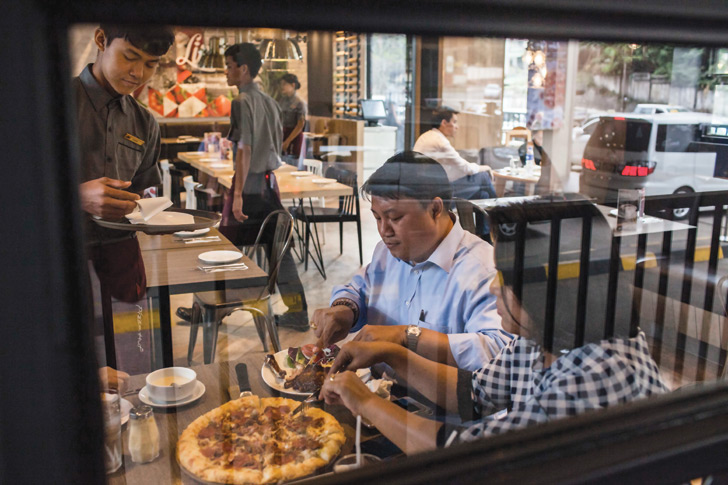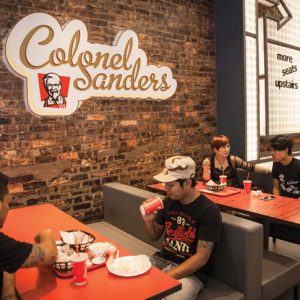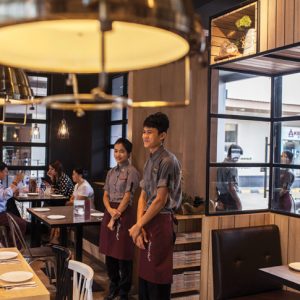From fast food giants to coffee chains, tobacco companies and garment makers, Myanmar’s emerging economy is opening up to the world’s biggest brands
It is just after 2pm at the newly built Pizza Hut on Yangon’s Dhammazedi Road. Clusters of staff throng around the entrance and waiters’ station as businessman Sein Min, who also goes by the name of David, sits down to eat with his family on his second visit to the chain.

Enjoying a shared meal comprising of pizza, seafood spaghetti and a rice dish, David sees a future for the restaurant, and believes consumers are likely to become hooked through the novelty factor. “Now, Burmese people they want to taste the different kinds of food available. In the last ten years, 20 years, we saw it on the television but we couldn’t taste it,” he says. “I think Pizza Hut will get success in Myanmar because people want to try it.”
The restaurant chain, which launched in Yangon late last year and intends to open up to 20 new outlets in the next five years, is among a slew of recognisable brands that have been lining up to enter the former pariah state, long closed to foreign influence and investment, in the hopes of positioning themselves as familiar favourites with local consumers.
South Korean chains were among the first fast food outlets to set up shop, with the arrival of Lotteria and BBQ Chicken in 2013. Purveyor of fried chicken KFC flung open its doors in June 2015, becoming the first major US restaurant chain to establish itself in the country. Australia’s Gloria Jean’s Coffees opened two outlets in Yangon in recent months.
This ‘fast food invasion’, as a local newspaper dubbed it, came hot on the heels of economic and political reforms in a country that had been ruled for decades by a military junta. A transformation to civilian-led governance – followed in November 2015 by free elections that saw Aung San Suu Kyi’s National League for Democracy (NLD) sweep to power – has held a magnetic allure for investors who had long been on the outside looking in.

“If you look at the demographics, it’s a very young population, not to mention large,” said Simon Arnold, general manager of Pizza Hut Myanmar. “So that in itself for any consumer brand is a big tick. It’s not particularly affluent yet, but the growth rate has potential to be fast.
“So, the fundamentals are there but the question is also: ‘Is this a market you can afford not to be in, and how many other markets have that untapped potential at this stage?’ And I think there aren’t many, so short of going into Iran or Cuba… Myanmar is one of the few remaining.”
With a virtually untapped consumer market of more than 50 million people, growth potential is clearly a major draw. Brands such as drinks manufacturers Coca-Cola and Pepsi, carmakers Ford and Chevrolet, and British American Tobacco have been quick to establish sales offices in the country. Cheap labour has also lured major garment manufacturers.
But it is the influx of internationally pervasive fast food chains that are the most visible markers of economic progress. Professor Nicholas Farrelly, a research fellow at Australian National University’s School of International, Political and Strategic Studies, told the Myanmar Times that the new operations are significant beyond an expansion in culinary options.
“The arrival of the global fast food heavyweights marks a turning point for supply chains, middle-class waistlines and international perceptions. Many will resent the arrival of such unhealthy harbingers of Western ways. But there will still be a level of excitement as some of the most recognisable brands and recipes in history sweep across the country,” he said.
Such brands are pursuing a strategy of early expansion in an emerging market where, despite Myanmar’s growing middle class, incomes generally remain low. Many will struggle to afford K5,000 ($4) for a two-piece chicken meal at KFC or K10,000 ($8) for one of Pizza Hut’s basic offerings. Last year, the government set a minimum wage of K3,600 ($2.90) a day.
GDP per capita is, however, set to rise, with BMI Research’s Asia Country Risk team forecasting that it will more than double between 2014 and 2019, from $1,480 to $3,052, fuelling “rapid” growth in food and beverage sales. Rising disposable incomes and optimistic consumer sentiment will be key drivers in this growth, according to the research firm’s Food & Drink Insights, while foreign investment is likely to continue picking up pace.

“Myanmar represents a long-term opportunity in the food and drink industry, which has been compared to Vietnam around 20 years ago,” it said. “Western companies, using joint ventures with local firms, will continue laying the foundations over the next few years for much larger manufacturing presences going forward.”
Pizza Hut’s Arnold said there are plenty of challenges for franchises opening in Myanmar, key among them attracting and retaining good staff. Jardine Restaurant Group, which operates Pizza Hut Myanmar in a joint venture with local firm City Mart Holding, sent its core management team to Ho Chi Minh City for three months of training.
“Myanmar is a very hot market at the moment when it comes to F&B, and any professional service as well, so once you’ve got an element of experience and training at an international company, I suppose you become very attractive in the talent pool and there’s definitely an imbalance between supply and demand,” he said.
Logistics are another test for those dipping their toes into the emerging market, an issue Pizza Hut hopes to overcome as it expands to other parts of the country. “Talking to suppliers on a one-store basis in a market that is problematic to deliver to is not a very attractive offer to them, but as we get a critical mass that should be easier, and as time goes on the local infrastructure will improve,” he said. “We’re already seeing from when I started the feasibility study one and a half to two years ago, the warehousing and cold chain have come a long way.”
In the end, however, the biggest test is whether these unfamiliar flavours can capture the loyalty of Myanmar’s diners. Ma Thet Su Wai, 27, a business owner, explained that she – and most Burmese people – generally preferred spicy and sour foods, but she was eating at a KFC in Yangon for the second time.
“I don’t like bread, just rice, but my husband likes burgers,” she explained, adding that she could, however, see some benefits in the advent of US fast food in Myanmar. “It’s good for our health because everything is clean like the oil and the chicken. It’s better than other food shops, like the roadside vendors.”
Both KFC and Pizza Hut – which are subsidiaries of Yum Brands but operated by different franchisees in Myanmar – have tried to tailor their menus to the local market, each offering rice dishes and dialing up the spice factor.

“We set up a test kitchen in May last year and we spent a lot of time with consumer groups, because it’s a very unique and rich culture here, so I don’t think you can just cut and paste something that’s worked in another market,” says Arnold. “While we weren’t necessarily changing the concept, we would tweak it and refine it to match local taste palates or preferences. [This is a] very Buddhist country, so there’s no beef on our menu [and] dialing up the spiciness of dishes was a big thing, hence [we have] 12 times the spiciness of some of our other markets.”
And although a 2013 report by the Boston Consulting Group estimated that less than 40% of Myanmar consumers frequented restaurants, Luc de Waegh, managing partner at Myanmar-based business advisory firm West Indochina, said this would still leave roughly 20 million restaurant-goers that such franchises can target. “This is bigger than many markets in the world,” he said. “It is very wise to expand as fast as possible. The price of expansion will only go up.”
De Waegh, however, cautioned that Myanmar was a unique market, and “replicating an entry strategy from another country will likely not work”. “You need to do homework on the ground… understand the consumers, meet people and align interest with a local party.”

